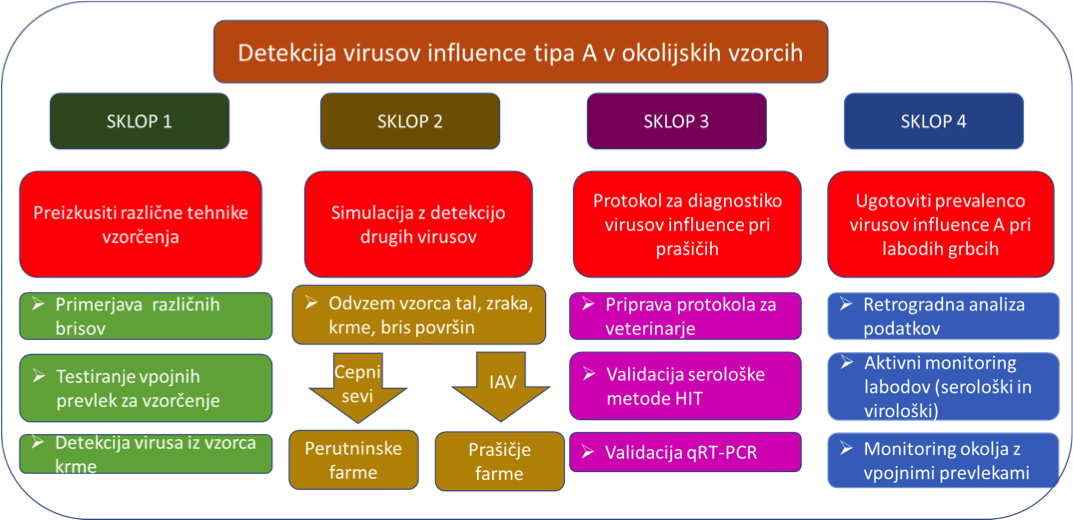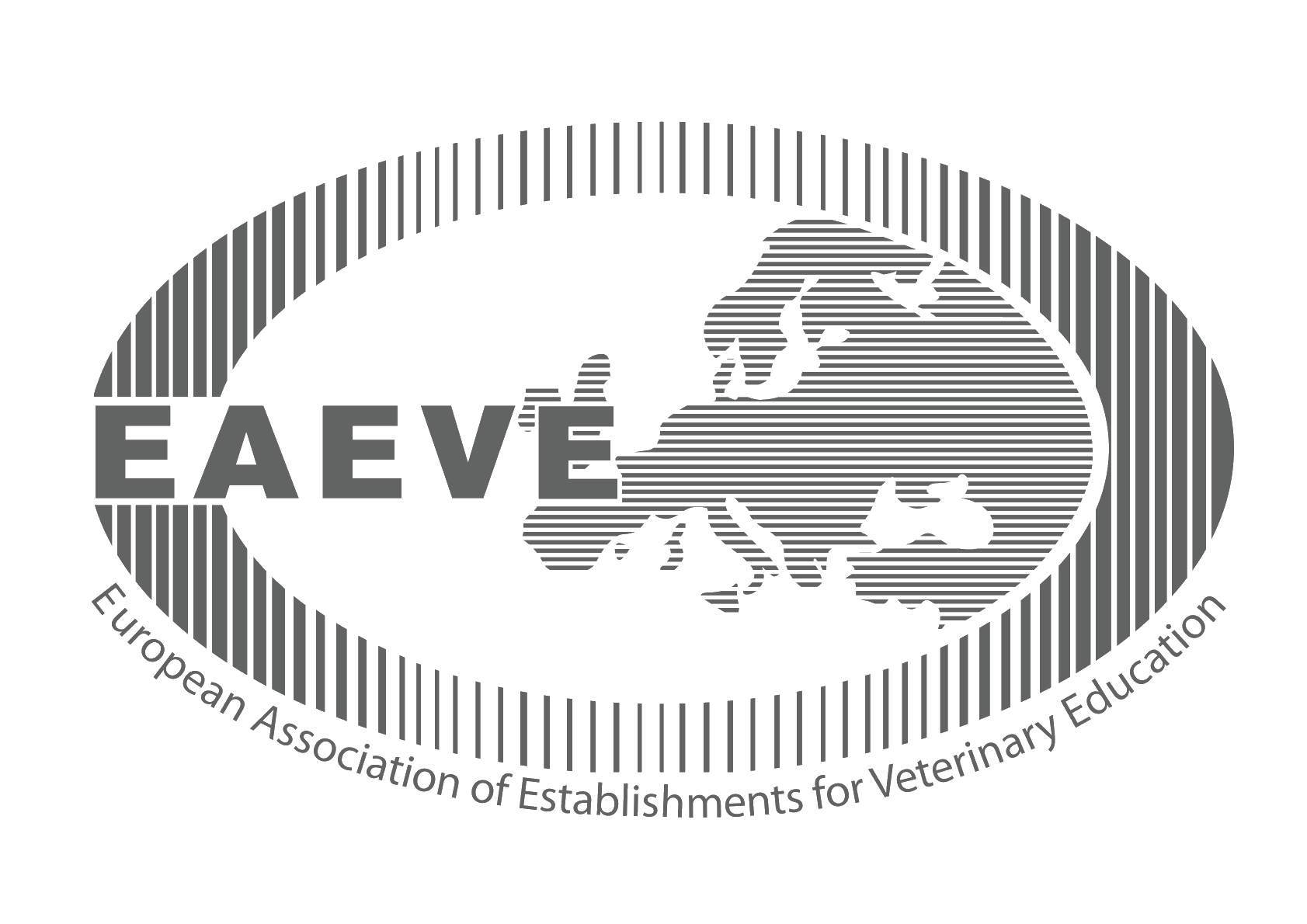V4-1803

Detection of type A influenza viruses in environmental samples, feed and animal bedding and development of an algorithm for the diagnosis of influenza in pigs

General Data
Member of UL: Veterinary Faculty
Partner: Prirodoslovni muzej Slovenije
Code: V4-1803
Project title: Detekcija virusov influence tipa A v okoljskih vzorcih, krmi in nastilju ter priprava algoritma za diagnostiko influence pri prašičih
Project period: 1.11.2018 – 30.4.2021
Cenovna kategorija: D
Annual extent: 190 hours of research work
Leader: dr. Brigita Slavec
Scientific field: Biotehnika/ Veterina/ Animalna patologija in epizootiologija (šifrant ARRS), Kmetijske vede in veterina/ Veterina (šifrant FORD)
Project description
Until the emergence of the highly pathogenic H5N1 virus of the A/goose/Guangdong virus line (Go/GD/96), only limited outbreaks of type A influenza were reported. The disease occurred mainly in domestic poultry; infections of humans with type A influenza viruses (IAVs) have only been sporadic. According to the World Health Organisation (WHO), 860 cases of human H5N1 infections were recorded between 2003 and May 2018, with a 53% mortality rate. Therefore, the fear of a new pandemic is justified. The great economic damage caused by viruses of the aforementioned lineage worldwide, in which the aspect of animal welfare is not negligible, is a major global problem. Despite the availability of vaccines, the disease is most often controlled by the killing of poultry.
The H5 subtype virus from cluster 2.3.4.4, which arrived in Europe via Russia in 2016, has so far caused the largest known pandemic in the European area. By August 2017, 1,207 outbreaks of domestic poultry reported from 24 European countries were confirmed and 1,590 outbreaks in wild birds in 29 European countries. In addition to the H5N8 subtype, the H5N5 subtype was also confirmed.
Poultry farming in Slovenia is one of the largest agricultural sectors, so protecting this sector from the occurrence of particularly dangerous infectious diseases is even more important. The same also applies to pigs, although the production of pig meat is slightly lower. It is particularly disadvantageous from the point of view of preventing influenza virus infections if there are large agglomerations of poultry and pigs in a relatively small area. The Slovenian situation is also characterised by smaller family farms where poultry and pigs are raised together, which can lead to the emergence of new subtypes of influenza viruses which are also dangerous for humans.
To date there have been two outbreaks of highly pathogenic Asian avian influenza (HPAI) in Slovenia, but only in wild birds. In both cases (2006 and 2017), the northeastern region was most affected. This is an area of intensive poultry production, whilst at the same time pig production is the most developed in the area. The epidemiological picture of pig infections with IAVs in Slovenia in the last decade is virtually unknown. Due to the great importance of pigs in the ecology of influenza viruses, one of the aims of the project is to identify which influenza viruses circulate in the pig population in Slovenia and to prepare sampling protocols for veterinary practitioners. Materials will also be prepared to raise awareness among breeders and other lay public about how to handle influenza in pigs. The data obtained through this project will thus contribute to an improved epidemiological picture of IAV circulation in the European area, and at the same time the analysis of the data obtained will help the competent authorities to plan effective preventive measures for the control of IAV in pigs in Slovenia.
Rapid and reliable diagnostics are essential for effective and rapid prevention of the spread of infectious diseases. In addition, it is of paramount importance that infectious agents are tracked in order to determine the origin of the entry and to check that the disinfection and purification measures have been effective. Although an epizootiological investigation is part of the statutory measures in the event of an outbreak, sampling of environmental samples is not foreseen in the action plan, nor is the verification of the effectiveness of disinfection. One of the aims of the proposed project is therefore to test the applicability of non-invasive sampling methods of various matrices such as air, soil surfaces and feed, and optimisation of IAV diagnostics on these samples. These methods will be tested at animal farms as well as in the environment where wild waterfowl are kept, which is one of the most important risk factors for the entry of the pathogen into poultry and pig production.
In both cases of HPAI outbreaks in Slovenia, mute swans (Cygnus olor) were the most affected. Why this is so is not yet clear. Hypothetically, it could be a consequence of population naivety in terms of the state of resistance of overcoming IAV. As part of the project, the epidemiology of IAV in mute swans will be investigated in the territories of northeast Slovenia. Their movement dynamics will also be looked into in order to obtain information on the critical points of possible IAV transfers to poultry and pig breeding.
It is believed that the proposed project will be of great importance in limiting the spread of avian influenza among animals and thus in reducing the risk of transmission to humans. Avian influenza is a global threat. Good biosecurity measures, which must be based on knowledge of the epidemiology and ecology of the virus in a particular area, as well as rapid and reliable diagnostics, provide effective protection against the prevention of virus entry and spread. Through targeted research it is believed that expected objectives outlined in the call for proposals will be met.
Project phases

Structure of the project group
The veterinarian on duty
Emergency veterinary assistance for dogs and cats and a telephone number of constant readiness.
Library
A wide selection of domestic and foreign professional literature in the field of veterinary medicine and other sciences.
Location
Gerbičeva 60
SI-1000 Ljubljana
Slovenija
Sample Reception
Samples are received at several locations throughout Slovenia. See where.
Main navigation
-
Education
- Informativni dan
- Why to become a veterinarian?
- Undergraduate Studies
- Postgraduate studies
- Pripravništvo
- Summer Schools
- Continuous education
- Professional Development
- International Activity
- Mednarodna dejavnost - Tuji študentje
- The Path to Creative Knowledge
- Tutoring
- Extracurricular Activities
- Career Centres
- Alumni
- Student organizations and societies
- Quality Assurance
- Clinics
- Diagnostics
- Dobrobit
- NVI
- Research
- About us
- Hub




